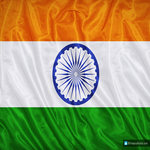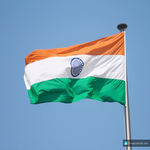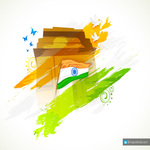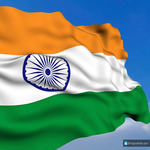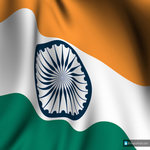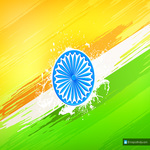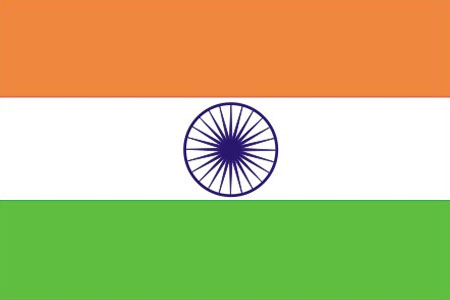
| National Flag of India |
| Disclaimer: All efforts have been made to make this image accurate. However Mapping Digiworld Pvt Ltd and its directors do not own any responsibility for the correctness or authenticity of the same. |
The Indian National Flag symbolises national pride and is one of the most respected national symbols. The late Prime Minister Jawaharlal Nehru called it "a flag not only of freedom for ourselves, but a symbol of freedom to all people."
As per the Indian laws, the national flag is to be made up of khadi. The flag code of India governs the usage of the flag. Initially, use of the flag by private citizens was prohibited, except on national days like Republic Day and Independence Day. But gradually, some changes were made by the Union Cabinet about the flag's use by private citizens. The code was amended about its usage for hoisting and its adaptation on other types of clothes.
The national flag is popularly known as Tiranga, which means "three colours" or "tricoloured". It is a horizontal tricolour in equal proportion of deep saffron at the top, white in the middle and green at the bottom. The ratio of the width to the length of the flag is 2:3. At the centre of the white band is a wheel with 24 spokes in navy blue colour that indicates the Dharma Chakra (Wheel of Law).
Blank India Flag for Kids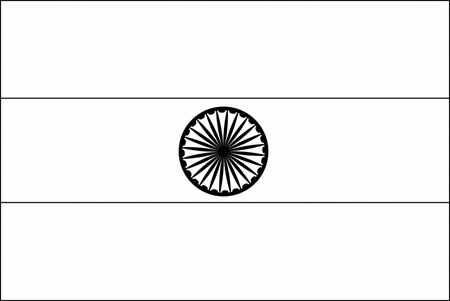
Saffron: Saffron is a symbol of courage and sacrifice.
White: The white colour represents honesty, peace and purity. It highlights the importance of maintaining peace in the country.
Green: The green colour represents faith and chivalry. It is a symbol of prosperity, vibrancy and life.
Ashoka Chakra: The Ashoka Chakra or the Dharma Chakra (Wheel of Law) has 24 spokes and appears on a number of edicts of Ashoka.
The Indian national flag represents India's long struggle for freedom. It signifies the status of India as an independent republic. The flag came into being in its present form at the meeting of Constitutional Assembly on 22 July 1947. Since then it has served as the National Flag of the Dominion of India from 15 August 1947 to 26 January 1950 and, thereafter, as the national flag of the Republic of India. The Indian National Flag was designed by Pingali Venkayya and contains three equal strips of saffron, white and green.
1904-06: The history of the Indian flag dates back to pre-independence era. It was between 1904 and 1906 that the first Indian flag came into being. It was made by an Irish disciple of Swami Vivekananda. Her name was Sister Nivedita and after some time this flag came to be known as Sister Nivedita's flag. This flag comprised the red and yellow colours. Red signified the freedom struggle and yellow was a symbol of victory. It had the words "Bonde Matoram" in Bengali written on it. The flag also contained a figure of 'Vajra', weapon of god 'Indra', and a white lotus in the middle. The 'Vajra' is a symbol of strength and lotus depicts purity.
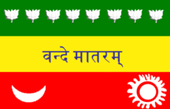
Indian flag in 1906: After Sister Nivedita's flag, another flag was designed in 1906. It was a tricolour with three equal strips of blue (top), yellow (middle) and red (lower). In this flag the blue strip had eight stars of slightly different shapes. The red strip had two symbols, one of sun and the other of a star and a crescent. The yellow strip had 'Vande Mataram' written on it in Devnagiri script.
In the same year another version of this flag was created. It was also tricolour but its colours were different. It had orange, yellow and green and came to be known as 'Calcutta flag' or 'Lotus flag', as it had eight half open lotuses on it. It is believed to be have been designed by Sachindra Prasad Bose and Sukumar Mitra. It was unfurled on 7 August 1906 at Parsi Bagan Square, Kolkata. The day was being observed as "boycott day" against the partition of Bengal and Sir Surendranath Banerjee hoisted this flag to mark the unity of India.
Indian flag in 1907: In 1907 came the Madam Bhikaji Rustom Cama's flag. The flag was collectively designed by Madam Bhikaji Cama, Vinayak Damodar Savarkar (Veer Savarkar) and Shyamji Krishna Varma. The flag was unfurled by Madam Cama on 22 August 1907 at Stuttgrat, Germany, and attained the status of the first Indian flag to be hoisted at a foreign land. From this event onwards it was also referred to as 'Berlin Committee flag'. The flag consisted of three colours- the topmost being green followed by golden saffron in the middle and the red colour at the bottom.
Indian Flag in 1916: In 1916 Pingali Venkayya, a writer and a geophysicist, designed a flag with the intention to bring the whole nation together. He met Mahatma Gandhi and sought his approval. Mahatma Gandhi suggested him to incorporate a charkha as a symbol of economic regeneration of India, in the flag. Pingali created the flag from hand spun yarn 'Khadi'. The flag had two colours and a 'Charkha' drawn across them but Mahatma Gandhi did not approve of it as he was of the opinion that red represented the Hindu community and green Muslims, but the other communities of India were not represented in the flag.
Indian Flag in 1917 :The Home Rule League formed by Bal Gangadhar Tilak adopted a new flag in 1917, as at that time the Dominion status was being demanded for India. The flag had the union jack at the top, near the hoist. The rest of the flag contained five red and four blue strips. It had seven stars on it in the shape of 'Saptarishi' constellation which is supposed to be the sacred one for Hindus. It also had a crescent moon and a star at the top fly end. This flag did not gain popularity among the masses.
Indian flag in 1921:As Mahatma Gandhi wanted all the communities of India to be represented in the flag of the nation, a new flag was designed. This flag had three colours. At the top was white then green and at the bottom was red. White symbolised minority communities of India, green Muslims and the red represented Hindu and Sikh communities. The 'Charkha' was drawn across all the bands symbolising the unification of these communities. The pattern of this flag was based on the flag of Ireland, another nation which was struggling to get its independence from Britain. Although the Congress Committee did not adopt it as its official flag but it was widely used as a symbol of nationalism in India's freedom struggle.
Indian flag in 1931: Some people were not happy with the communal interpretation of the flag. Keeping this in view, a new flag was designed which replaced red with ochre. This colour signified the combined spirit of both religions as saffron was the colour of Hindu yogis as well as Muslim darvesh. But the Sikh community also demanded a separate representation in the flag or the complete abandonment of religious colours. This resulted in another flag by Pingali Venkayya. This new flag had three colours. Saffron was at the top followed by white in the middle and green at the bottom. The 'Charkha' was placed at the center. This flag was passed at the meeting of Congress Committee in 1931 and was adopted as the official flag of the Committee.
Indian flag in 1947: When India got independence, a committee headed by Rajendra Prasad was formed to select the National Flag of India. The committee decided to adopt the flag of Indian National Congress, with suitable modifications, as the flag of independent India. As a result, the flag of 1931 was adopted as Indian flag but 'Charkha' in the middle was replaced by 'Chakra' (wheel) and hence our National Flag came into being.
British India Flag 1858-1947:This flag introduced by British India in 1858. The design of the flag was based on western heraldic standards and it was similar to flags of other British colonies, including Canada and Australia. The blue banner included the Union Flag in the upper-left quadrant and a Star of India capped by the royal crown in the middle of the right half.
Manufacturing: The 'Bureau of Indian Standards (BIS)' sets standards for the manufacture of the flag. It specifies the cloth, dye, colour, and thread count besides laying out rules regarding its hoisting. The Indian flag can only be made of 'Khadi'. It is made of two types of khadi - one for its main part and the other one for the cloth that holds the flag to the staff.
The flag is a national symbol and is respected by every Indian. There are certain dos and don'ts laid down for common people regarding the flag:





